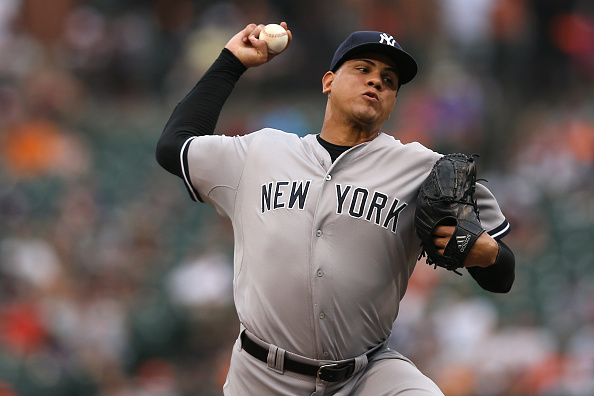Early on during the 2015 regular season, the Yankees bullpen has been a constant topic of discussion.
With the dominance of Dellin Betances and Andrew Miller to the struggles of other relievers, the Yankees bullpen seems to get a lot of attention, as many people feel that the team will live or die by how their bullpen performs.
Before we start to break down the numbers individually, let’s take a look at where the bullpen ranks with the rest of the Major League teams in some major statistical categories (As of June 16, 2015):
Wins: 10 (Tied 12th)
Losses: 7 (Tied Eighth Lowest)
Saves: 21 (Tied Fifth Most)
Innings Pitched: 203.0 (Eighth most)
ERA: 3.24 (9th Lowest)
AVG: .205 (Third Lowest)
WHIP: 1.16 (Tied Fourth Lowest)
Hits: 154 (Seventh Lowest)
HRs: 17 (Tied 11th Lowest)
Walks: 81 (Tied Fifth Most)
HBP: 12 (Tied Second Most)
Strikeouts: 221 (Most)
The numbers for the Yankees bullpen can be pretty deceiving. If you take the two-headed monster of Betances and Miller out of the equation, the rest of the bullpen so far has been rather inconsistent. With Miller out for an extended period of time due to injury, the Yankees need relievers to step up to help get the ball to Betances in save situations.
We’ve heard (and sometimes complained) about the struggles of guys such as David Carpenter and Esmil Rogers, but as the Yankees shuffle through relievers, how come some of these pitchers have trouble getting outs?
Here’s part of the problem: hitters are making too much contact against them.
Yes, when the opponent is able to make contact, eventually contact is going to turn into hits, and hits sometimes turn into runs. When the pitcher is able to utilize his pitches and get batters to miss, there is a much better likelihood that the hitter will be retired.
When you compare Betances and Miller to guys such as Carpenter, Rogers, and even Chris Martin, you can see a huge difference in overall statistics. Of course, Carpenter has been recently traded and Rogers was designated for assignment by the team, but it is still worth while to look at why these guys struggled with the Bronx Bombers.
As per Fan Graphs, here are the contact percentage numbers for these five pitchers:
O-Contact%- Number of pitches on which contact was made on pitches outside of the strike zone/Swings on pitches outside the strike zone
Z-Contact%- Number of Pitches on which contact was made on pitches that were in the strike zone/Swings on pitches inside the strike zone
Contact%- Number of pitches on which contact was made/Swings made by the batters
[efsrow]
[efscolumn lg=”4″ md=”4″ smoff=”0″ mdoff=”0″ lgoff=”0″ ]
O-Contact%
Martin- 76.7%
Rogers- 67.)%
Carpenter-58.5%
Betances- 38.8%
Miller- 30.9%
[/efscolumn]
[efscolumn lg=”4″ md=”4″ smoff=”0″ mdoff=”0″ lgoff=”0″ ]
Z-Contact%
Martin- 90.3%
Rogers- 84.7%
Carpenter- 82.8%
Betances- 75.2%
Miller- 74.2%
[/efscolumn]
[efscolumn lg=”4″ md=”4″ smoff=”0″ mdoff=”0″ lgoff=”0″ ]
Contact%
Martin- 85.2%
Rogers- 78.9%
Carpenter- 75.4%
Betances- 61.2%
Miller- 56.4%
[/efscolumn]
[/efsrow]
The trend here speaks for itself: the pitchers who struggle to get swing and misses outside of the strike zone tend to let up more contact inside the strike zone as well. In these instances, the more contact allowed definitely doesn’t benefit the pitcher very often.
You might be wondering by looking at these numbers why hitters are having so much success hitting the ball outside of the strike zone. Maybe it has to do with pitch selection.
As a pitcher, it’s important to keep the hitter off-balance, not allowing them to know what’s coming. Betances and Miller both only use two specific pitches, but both are able to throw off the batter’s timing due to the fact they mix their pitches well.
With the other relievers, it seems as if a common trend of throwing fastballs has been an issue. Out of the Yankee relievers who have thrown more than 10 innings this season in relief, only one (Betances) has thrown less than 50% of his pitches as fastballs.
Percentage wise, the Yankees have four relievers who threw more than 55% of their pitches as fastballs. Of the four, three have either been traded or demoted to the minors at some point this season. The other reliever (Justin Wilson) is a hard-throwing lefty who really doesn’t have an off-speed pitch, but has been relatively effective for the Yankees so far.
What this goes to show you is this: the Yankees relievers moving forward have to do a better job at mixing their pitches. It’s crucial to keep hitters guessing at the plate, so the contact rate stays at a minimum. Of course, major league hitters are going to put the ball in play, but it does help to limit the damage.
By these numbers, you can see why some of these relievers have had a hard time succeeding with the big league club. If the Yankees want to be successful in regards to their pitching, they are going to need guys to step up and get key outs. The club had a dominant bullpen in mind when they put this team together during the off-season, so it’s time the rest of the bullpen steps up and gets the job done.
With our next piece, we’ll take a look at different match ups and situations, seeing who manager Joe Girardi likes to go to in certain situations. We’ll break down the numbers against right-handed and left-handed hitters, and also examine the numbers throughout different instances in ball games.




